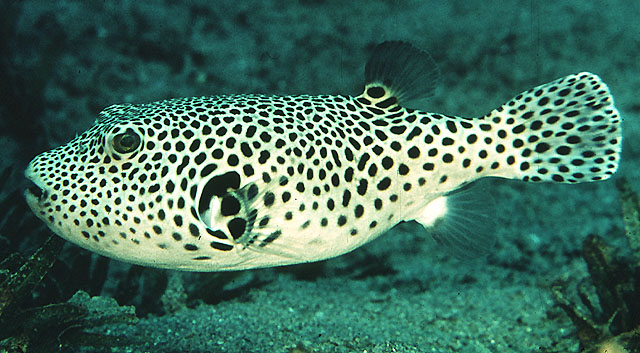| Tetraodontidae (Puffers), subfamily: Tetraodontinae |
| 120 cm TL (male/unsexed) |
|
reef-associated; brackish; marine; depth range 3 - 58 m |
| Indo-Pacific: Red Sea and East Africa eastward through Indonesia to Tuamotus, northward to southern Japan, southward to Lord Howe Island. |
|
Dorsal spines (total): 0-0; Dorsal soft rays (total): 10-12; Anal spines: 0-0; Anal soft rays: 10-11. Body covered with prickles (Ref. 559). Juveniles with dark stripes on belly, becoming spots with growth; adults with or without spots on fin (Ref. 4919).
Description: Characterized further by pale grey body color with dense covering of black spots on head, body and fins; large black spots or irregular blotches around bases of pectoral and dorsal fins; head and body with small spinules except top of snout, base of fins and side of caudal peduncle, best developed spinules on ventral surface; short snout, length about 1.7-2.7 in head length; bony interorbital width 2.2-2.4 in head length; rounded caudal fin, length 4.0-5.0 in SL (Ref. 90102). |
| Relatively uncommon in patch reefs and coral slopes near sandy areas of clear lagoon and seaward reefs. Juveniles occur in sandy and weedy inner reefs, adults on clear lagoons and seaward reefs (Ref. 9710). Juveniles inshore, usually on muddy substrates and often estuarine. Adults on deep slopes and range to outer reefs, sometimes swimming high above the substrate or just below the surface. Pelagic larvae may disperse over great distance and juveniles occur in subtropical zone (Ref. 48637). Enter estuaries (Ref. 4833). Considered as the giant among puffers reaching a total length well in excess of a meter. |
|
Least Concern (LC); Date assessed: 07 June 2011 Ref. (130435)
|
| poisonous to eat |
|
Collected off Jizan, southern Saudi Arabian Red Sea coast (Ref. 99978). |
Source and more info: www.fishbase.org. For personal, classroom, and other internal use only. Not for publication.

